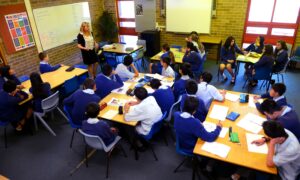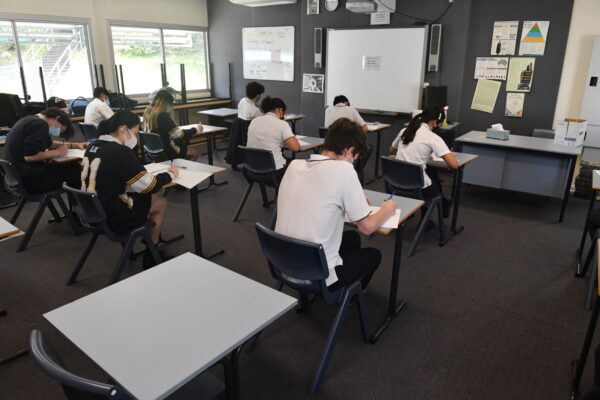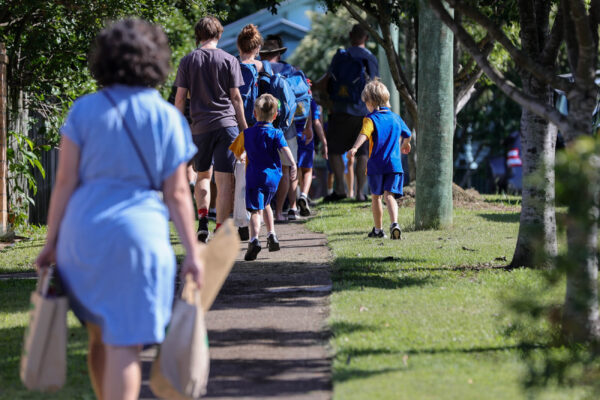Remedying Australia’s Teacher Shortage
CommentaryOn Aug. 12, Australia’s education ministers released a National Action Plan on the teacher shortage. But reading the ministers’ statement on the action plan reveals that the proposed strategies amount to not much more than aspirational comments. The statement indicates that the education ministers paid tribute to teachers for their work, acknowledged the critical role they play, and applauded the existing cohort of teachers for their resilience and dedication during the pandemic. But behind its promises of action, the plan lacks the detail and depth to constitute a meaningful proposal. Certainly, the education ministers correctly characterised the problem of a teacher shortage as a challenging issue. However, nowhere in the statement is there an attempt at understanding the root causes of the problem. There is overwhelming evidence that, during the pandemic, teachers either left or contemplated leaving the teaching profession because of the oppressive administrative duties placed upon them. In this context, University of Sydney academics, Rachel Wilson and Giuseppe Carabetta, have noted that: “Australia’s teachers suffer from poor professional status. A lack of respect, problems with recruitment, poor pay (relative to other professions), high workload, conflicting demands, and now the pandemic have conspired to create a perfect storm.” The classroom has become a place where the oppressive management of education by the states and territories’ bureaucracies has compromised the ability of excellent teachers to mentor high-achieving children. Year 12 students pose for a media opportunity following their first HSC exam at Sydney Secondary College in Sydney, Australia, on Nov. 9, 2021. (AAP Image/Mick Tsikas) In addition, the absurdities of a woke curriculum have further alienated committed teachers who would otherwise welcome opportunities to teach practical skills. The incessant demand to implement the agenda of the progressive elites is stifling the imagination and entrepreneurial qualities of the best teachers who, consequently, consider leaving the system to pursue other opportunities. Band Aid Solution Creating Incompetent Teachers A review of the proposed action plan reveals its aspirational nature. It concentrates on five priority areas: elevating the profession, improving teacher supply, strengthening initial teacher education, maximising the time to teach, and a better understanding of future teacher workforce needs. Of course, any knowledgeable observer knows that an improvement in the supply of teachers is urgently required. At times, universities have responded to this need by lowering the ATAR score for teacher training courses. But the consequence of this approach is to graduate teachers who do not have the literacy and numeracy skills to teach confidently and competently. This situation presents institutions of higher learning with a major challenge because an increase in the ATAR score is likely to reduce, not increase, the supply of teachers. It is surprising to read in the statement that the education departments will work on a plan “to ensure all first-year students have an opportunity to undertake high-quality placements in schools, undergo an initial assessment of their literacy and numeracy skills in their first year, and ensure they can receive targeted support if they need it.” This suggests that students are admitted to teaching degree programs even though they may not have the necessary skills to contribute to and profit from their tertiary studies. The proposal thus promises remedial action to ensure that a sufficient number of students graduate with a teaching degree. Lacking Quality Education There are many reasons for the teacher shortage malaise, including the accumulative effect of half a century of neglect. In my book ‘Enduring Ideas: Contributions to Australian Debates’ I noted in 1992 that: “Those of us who have or had children in high schools and are seriously concerned about the quality of Australian education could not have failed to notice the alarming signs which are symptomatic of decline.” Hence, much more needs to be done in primary and high schools to adequately prepare students who want to pursue a teaching degree at university which, using the language of Cardinal John Henry Newman, facilitates the acquisition of a habit of mind “of which the attributes are freedom, equitableness, calmness, moderation, and wisdom.” Students are seen entering school grounds for their first day back of the year in Brisbane, Australia, on Feb. 7, 2022. (AAP Image/Russell Freeman) There is overwhelming anecdotal evidence that too many students today finish high school but cannot think properly and have not learnt to be critical contributors to our democracy. The first-listed priority in the ministers’ statement is “elevating the profession.” It envisages “how awards and honours might be used to reward and recognise the teaching profession.” While perfect

Commentary
On Aug. 12, Australia’s education ministers released a National Action Plan on the teacher shortage. But reading the ministers’ statement on the action plan reveals that the proposed strategies amount to not much more than aspirational comments.
The statement indicates that the education ministers paid tribute to teachers for their work, acknowledged the critical role they play, and applauded the existing cohort of teachers for their resilience and dedication during the pandemic.
But behind its promises of action, the plan lacks the detail and depth to constitute a meaningful proposal.
Certainly, the education ministers correctly characterised the problem of a teacher shortage as a challenging issue. However, nowhere in the statement is there an attempt at understanding the root causes of the problem.
There is overwhelming evidence that, during the pandemic, teachers either left or contemplated leaving the teaching profession because of the oppressive administrative duties placed upon them.
In this context, University of Sydney academics, Rachel Wilson and Giuseppe Carabetta, have noted that: “Australia’s teachers suffer from poor professional status. A lack of respect, problems with recruitment, poor pay (relative to other professions), high workload, conflicting demands, and now the pandemic have conspired to create a perfect storm.”
The classroom has become a place where the oppressive management of education by the states and territories’ bureaucracies has compromised the ability of excellent teachers to mentor high-achieving children.

In addition, the absurdities of a woke curriculum have further alienated committed teachers who would otherwise welcome opportunities to teach practical skills.
The incessant demand to implement the agenda of the progressive elites is stifling the imagination and entrepreneurial qualities of the best teachers who, consequently, consider leaving the system to pursue other opportunities.
Band Aid Solution Creating Incompetent Teachers
A review of the proposed action plan reveals its aspirational nature. It concentrates on five priority areas: elevating the profession, improving teacher supply, strengthening initial teacher education, maximising the time to teach, and a better understanding of future teacher workforce needs.
Of course, any knowledgeable observer knows that an improvement in the supply of teachers is urgently required. At times, universities have responded to this need by lowering the ATAR score for teacher training courses. But the consequence of this approach is to graduate teachers who do not have the literacy and numeracy skills to teach confidently and competently. This situation presents institutions of higher learning with a major challenge because an increase in the ATAR score is likely to reduce, not increase, the supply of teachers.
It is surprising to read in the statement that the education departments will work on a plan “to ensure all first-year students have an opportunity to undertake high-quality placements in schools, undergo an initial assessment of their literacy and numeracy skills in their first year, and ensure they can receive targeted support if they need it.”
This suggests that students are admitted to teaching degree programs even though they may not have the necessary skills to contribute to and profit from their tertiary studies. The proposal thus promises remedial action to ensure that a sufficient number of students graduate with a teaching degree.
Lacking Quality Education
There are many reasons for the teacher shortage malaise, including the accumulative effect of half a century of neglect.
In my book ‘Enduring Ideas: Contributions to Australian Debates’ I noted in 1992 that: “Those of us who have or had children in high schools and are seriously concerned about the quality of Australian education could not have failed to notice the alarming signs which are symptomatic of decline.”
Hence, much more needs to be done in primary and high schools to adequately prepare students who want to pursue a teaching degree at university which, using the language of Cardinal John Henry Newman, facilitates the acquisition of a habit of mind “of which the attributes are freedom, equitableness, calmness, moderation, and wisdom.”

There is overwhelming anecdotal evidence that too many students today finish high school but cannot think properly and have not learnt to be critical contributors to our democracy.
The first-listed priority in the ministers’ statement is “elevating the profession.” It envisages “how awards and honours might be used to reward and recognise the teaching profession.” While perfectly reasonable, this proposal is like veneering a house’s sundeck that is already rotten. It will simply cover up the deficiencies of the teaching profession for a brief time.
Addressing Teacher Supply
For improving teacher supply, the education ministers have agreed “to further the internship model to increase the number of final year students working in schools … and investigate options for new commissioning and procurement models.”
But that may be counterproductive because any time spent in schools has the potential to turn interns away from the teaching profession due to the glaring curriculum failures or the oppressive control of the bureaucracy.
In contrast, the promise to explore “incentives like scholarships for teaching degrees to complement existing programs” and to offer improved financial terms to excellent teachers is a tangible way to retain teaching professionals.
The proposal to bring in more international teachers, however, is even more promising, especially if they are sourced from countries with an excellent education system. To that end, the ministers will work together to prioritise visa processing times for qualified teachers.
Overall, the National Action Plan on teacher shortage is a welcome statement on the part of the education ministers to improve the supply of teachers and to provide their pupils with an education that prepares them well for life’s challenges. But it does not seriously address the desire on the part of excellent teachers to have the flexibility to enthuse their students without the oppression of Australia’s education bureaucracy.
Views expressed in this article are the opinions of the author and do not necessarily reflect the views of The Epoch Times.












